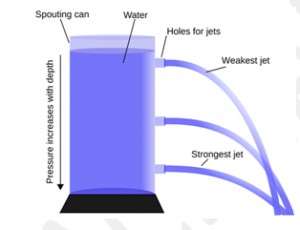Oracle IAS, the best coaching institute for UPSC/IAS/PCS preparation in Dehradun brings to you UKPCS Science (paper #6- Pressure
Pressure is defined as force per unit area. It is usually more convenient to use pressure rather than force to describe the influences upon fluid behavior. The standard unit for pressure is the Pascal, which is a Newton per square meter.

Atmospheric pressure, sometimes also called barometric pressure, is the pressure within the atmosphere of Earth (or that of another planet). In most circumstances atmospheric pressure is closely approximated by the hydrostatic pressure caused by the weight of air above the measurement point. As elevation increases, there is less overlying atmospheric mass, so that atmospheric pressure decreases with increasing elevation.
Atmospheric pressure is caused by the gravitational attraction of the planet on the atmospheric gases above the surface. The standard atmospheric pressure is 760 mm of Hg. The height is measured from the mean sea level.
Hydrostatic pressure is the pressure that is exerted by a fluid at equilibrium at a given point within the fluid, due to the force of gravity. Hydrostatic pressure increases in proportion to depth measured from the surface because of the increasing weight of fluid exerting downward force from above.

Real life utility of:
Hydrostatic pressure:
1) By holding large amounts of water back behind a dam, and then letting it spill slowly thru turbines, electricity can be generated thanks to hydrostatic pressure.
2) Another way to use hydrostatic pressure, is by building a water tank that is sitting very high up.
3) At hospitals, where a patient has a catheter (the clear plastic bag with water and nutrients) and this catheter is placed much higher up than the patient, so hydrostatic presure will push the water and nutrients into the patient’s bloodstream.
Atmospheric Pressure:
- inflating tires
- playing musical “wind” instruments
- drinking through straws
- flushing toilets
- vacuum cleaner
Contents hidePrinted notes topic wise – Contact us
Cost- Rs.5000/- (including shipping)
(~2500+ pages)
UKPCS Mains Study Material subject wise
The notes are strictly as per UKPCS syllabus (topic wise):
Individual Polity Cost: Rs. 1500/- (including shipping)
Individual S&T Cost: Rs. 1500/- (including shipping)
Individual Geography Cost: Rs. 1500/- (including shipping)
Individual Economics Cost: Rs. 1000/- (including shipping)
Individual Ethics Cost: Rs. 1000/- (including shipping)
Individual History Cost: Rs. 1500/- (including shipping)
Contact us for:-
-
-
-
-
-
-
- Upper Mains UKPCS Classroom program
- UKPCS Upper Test Series
- UKPCS Lower Test Series
- UKPCS Lower Classes
- UKPCS Past year papers
- Phone Number:–9997453844
- Telegram channel : click here
-
-
-
-
-
-
- UKPCS Upper Mains 2024 Study Material : Prepared by Experts Topic wise - April 6, 2024
- UKPSC Mains 2024:New Syllabus Pattern - April 6, 2024
- Oracle IAS’s Mentorship Program for UKPCS 2024 Pre Exam - March 21, 2024
